2. 武汉大学地球空间环境与大地测量教育部重点实验室, 武汉 430079;
3. 武汉大学地球空间信息科学协同创新中心, 武汉 430079;
4. 中国地质大学(武汉)多尺度地球成像湖北省重点实验室, 武汉 430074;
5. 中国地质大学(武汉)地质过程与矿产资源国家重点实验室, 武汉 430074;
6. 中国科学院测量与地球物理研究所大地测量与地球动力学国家重点实验室, 武汉 430074
2. Key Laboratory of Geospace Environment and Geodesy, Ministry of Education, Wuhan 430079, China;
3. Collaborative Innovation Center of Geospace Information Science, Wuhan University, Wuhan 430079, China;
4. Subsurface Multi-scale Imaging Laboratory, China University of Geosciences, Wuhan 430074, China;
5. State Key Laboratory of Geological Processes and Mineral Resources, China University of Geosciences, Wuhan 430074, China;
6. State Key Laboratory of Geodesy and Earth's Dynamics, Institute of Geodesy and Geophysics, Chinese Academy of Sciences, Wuhan 430074, China
The pore fluid behaviors through the free surface make the boundary more complex as fully drained, fully sealed and partially drained conditions. These effects are taken into account in surface wave secular equation derivation and closed-form dynamic response investigation. Complex searching algorithm and fast coverage quadrature are applied in the dispersion and response calculation. Typical near surface earth media are selected. For weakly consolidated media in which the surface wave propagates in an extremely low velocity, the effects of the motion of source are obtained. The partial saturation of mesoscopic loss significant in seismic frequency band is introduced beyond the Biot model. The effective viscoelastic model that has been used for body waves in porous media is extended to solve the boundary value problem of surface wave propagation by coupling body wave representations on the free surface.For one fluid saturated,
R1 mode wave can propagate under each boundary condition, which is similar with classic Rayleigh wave in elastic media. Its phase velocity is a little less than the Swave and amplitude is strong in seismograms. Due to the intrinsic attenuation, R1 wave is dispersive in the homogeneous half space. The velocities and attenuation coefficients are different under different fluid boundary conditions. Biot solid-fluid coupling coefficient controls the critical frequency of dispersion as for the body waves. High solid-fluid coupling can eliminate the differences. Tortuosity affects R1 waves for different fluid boundaries with different sensitivities. R2 mode appears and propagates under sealed and partially drained conditions. Its phase velocity is a little less than P2 wave. In most cases, it is difficult to be observed in dynamic responses. However, when the solid-fluid coupling is low, it may obtain the radiation from R1 wave as a non-physical wave with strong amplitude under partially drained surface. When the velocity of surface wave is low in weak media, the movement of source impulse with regards to the receiver makes remarkable effects on surface wave responses. Radical velocity to the receiver makes Doppler frequency shift. Lateral velocity makes distortions of wave responses in time and frequency domains. For partial saturation with heterogeneous multiphase fluid saturated patches, the mesoscopic flow induced by wave can interpreter wave attenuation in seismic frequency band, which is accordance with the practical data. Because the fast P1 wave is dominantly affected by this strong loss mechanism, R1 wave is more distinctively related to P1 wave considering partial saturation, quite different to the Biot fluid saturated model. The critical frequency for mesoscopic mechanism is controlled by fluid compositions in the patches, which in turn presents the correlation for surface wave signals to subsurface fluid distribution and flowing. Because the Biot critical frequency is always high, standard linear viscoelastic solid can effectively represent R1 wave propagation in porous media in seismic frequency band by the coupling body wave fits and ignoring the slow wave perturbation, especially for the dynamic responses in the time domain. While in patchy saturation model, the P wave propagates under the interactive wave induced flow between the two P wave modes, which also make it simple to effectively represent.
The fluid phase in near surface media can be regarded as an important factor for surface wave data acquisition and processing. The effects of different fluid free surfaces need to be considered for correction in several unconsolidated and high permeability rocks. The low velocity of the surface wave makes the movement of source be an important impact in the frequency responses. For passive surface wave observation usually with low frequency signal extraction, this impact needs to be carefully estimated. The dominated mesoscopic mechanism in seismic frequency band shows obvious attenuation in the P wave, which also dominates the surface wave propagation. For near surface attenuation estimation by surface wave, the P wave must be paid attention to. The developed effective medium saves the storage and time consumption for surface wave in porous media, which can be applied in the inversion modeling for surface wave image in an economic way.
体波(P波和S波)在地表干涉产生沿自由表面传播的面波(Rayleigh波、Love波等).通过反演频散的面波速度,可获得不同尺度地下S波速度(Aki and Richards,1980).面波方法已广泛地应用于水文、工程、环境、地质和地球物理等科学研究中.但该方法普遍基于弹性介质中面波的传播特性,经典线弹性理论是面波资料采集、处理和反演的理论基础(Song et al.,1989; Misiek et al.,1997; Xia et al.,1999,2002,2003,2004,2006a,2006b,2007,2008,2009; Winsborrow et al.,2003; Xu et al.,2006,2007; Luo et al.,2007,2008a,2008b,2009a,2009b; Safani et al.,2006; Song et al.,2007; Zeng et al.,2007,2011)
然而浅地表介质,通常都由富含孔隙的固体构成,孔隙中充填流体.这种介质的不均匀性会使波动传播显示出更复杂的特征.含流体孔隙介质理论较弹性理论更精确地揭示波动在真实介质中的传播规律.Biot提出的多相介质理论(Biot,1941,1956,1962)将固体和流体耦合的宏观效应作为描述波动传播的物理机制.理论预言的慢P波随后被实验证实(Plona,1980).该理论也成为研究孔隙介质中波动特征的基石.对于孔隙介质中的体波,近几十年已有较充分的论述(Carcione,2007),但是面波源于自由表面体波的干涉,传播特征更复杂,研究相对缺乏,限制了实际应用.故研究地震探测频带内孔隙介质中面波频散、衰减,以及动态响应特征是发展顾及含流体孔隙介质特征高精度面波方法的关键.
本文从几个方面回顾我们团队近几年在含流体孔隙介质中面波传播特征以及应用的研究,为进一步在实际面波探测中引入多相孔隙介质模型提供参考.
2 流体自由表面的边界效应Deresiewicz和Skalak(1963)发现若自由表面存在流相,界面上孔隙疏通性的不同,存在“开放孔隙”,“闭合孔隙”,以及部分疏通多种边界条件.面波传播会受到多种流体自由表面边界效应的影响.基于Biot流体饱和模型的面波有零碎的研究.如Jones(1961)研究开放孔隙下孔隙介质半空间中Rayleigh面波,发现流体无黏性时仅存的一种无频散的面波.Deresiewicz(1962)进一步考虑流体黏滞性,面波发生频散,速度在一定频率下存在局部极小.Paul(1976a,1976b)分析在自由表面稳态载荷的情况下包含面波的浅地表孔隙介质的位移响应.Tajuddin(1984)也基于无黏性流体,调查自由表面开放孔隙和闭合孔隙对面波传播的影响.Halpern和Christiano(1986)分析自由表面谐振下孔隙介质的动态响应.Philippacopoulos(1988)提出孔隙介质的Lamb问题,通过4个位移势函数获得开放孔隙下三维动态Green函数.Senjuntichai和Rajapakse(1994)研究相应的二维问题.国内学者王立忠等(1996)和杨峻等(1997)简化Biot模型,计算出稳态激振下的半空间孔隙介质的动态响应.夏唐代等(1998,2004)提出忽略固流耦合的惯性效应的孔隙土力学模型,研究其中面波的频散和应力响应特征.刘凯欣和刘颖(2003)考虑孔隙介质各向异性对面波传播的影响.国内学者仅仅考虑开放孔隙条件.近年来也有学者发现闭合孔隙下,存在两种类型面波(Edelman and Wilmanski,2002; Edelman,2004; Albers and Wilmanski,2005; Gerasik and Stastna,2014).鉴于浅地表存在疏松土层、 沥青路面,对应开放孔隙和闭合孔隙,以及两种极端情况之间更普遍的部分疏通条件,充分研究流体自由表面的边界效应对面波传播的影响很有必要.
除与弹性介质一样的固相应力边界条件(Carcione,2007),流体自由表面边界条件可写成(Deresiewicz and Skalak,1963)

其中χ代表自由表面渗透刚度,决定于地表的疏通条件和孔隙流体的表面张力.wz和p分别代表流体垂直于边界的位移和孔隙流体压力(Biot,1962).当χ→∞,p(x,y,z,t)|z=0=0,对应开放孔隙;当χ =0,∂twz(x,y,z,t)|z=0=0,对应闭合孔隙.除此之外为部分疏通状态.通过固相应力和方程(1)构成边界条件约束Biot波动方程(Biot,1956,1962),即可获取含流体孔隙介质中面波传播的数学模型.
选取一组典型孔隙介质参数(见表 1),对应典型的含孔隙砂砾或礁石堆积物完全水饱和.其中λ和μ是骨架的拉梅常数,α和M是Biot参数,ρ和ρf分别是介质和流体的密度,η和k分别是流体的动态黏滞度和介质的宏观渗透率.
| 表 1 孔隙介质模型参数 Table 1 Model properties of a porous medium |
图 1所示该介质在开放孔隙、闭合孔隙和χ=0.1情况下,求解半空间Rayleigh面波久基方程(Zhang et al.,2011)得到的地震探测频带内面波频散的相速度和衰减系数(复波数的虚部).第一类Rayleigh模式面波(R1波,图 1a),所有条件下都比S波慢(约0.9VS). 三种情况下速度特征相似,类似弹性介质中的Rayleigh面波.低频趋近等效Gassmann介质中的面波速度.随频率增大,开放孔隙下R1波传播稍慢.低频端R1波的衰减系数显示出f2 频率依赖关系,频率增高,转化为f1,和S波不同(Zhang et al.,2011).开放孔隙下R1波在10~100 Hz范围有更小的衰减.在0.5 Hz左右,部分疏通下R1波衰减为负值,呈现非物理模式.这种现象有待进一步探讨(图 1a右).第二类面波(R2波,有文献也称为渗漏Stoneley波(Albers and Wilmanski,2005))只在闭合孔隙和部分疏通时出现,类似孔隙介质中慢P波——P2波(图 1b).低频端R2波相速度和衰减系数都显示f1/2频率依赖,有很强耗散性.在整个频率范围内,R2波的速度比P2波稍小,随频率增高,趋于一速度极限.在部分疏通时,R2波衰减在大于40 Hz转向-f1,与闭合孔隙时R2波衰减随频率增高趋于一常数,并稍大于P2波衰减不一样(见图 1b右).
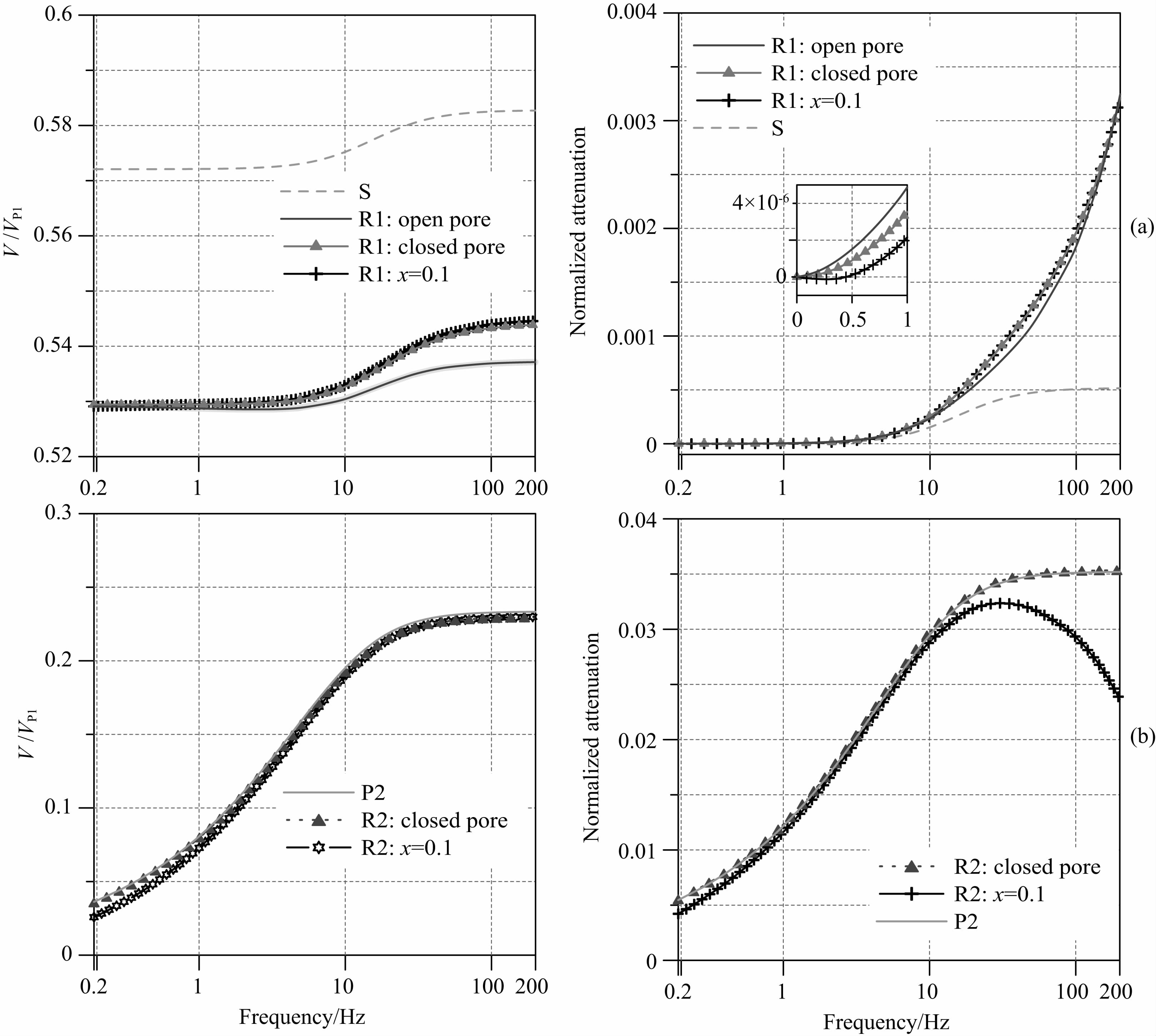 |
图 1 三种流体自由边界下表 1孔隙介质中两类面波的相速度和衰减系数频散,速度和衰减都由干骨架中快P波——P1波参数归一化,参照的体波也绘制出 (a)R1 波;(b)R2波. Fig. 1 Phase velocities and attenuation coefficients of two surface wave modes in porous media corresponding to Table 1 under three fluid free surface boundaries. The velocity and attenuation is normalized by P1 wave in dry frame (a)R1 wave;(b)R2 wave. |
固流耦合系数b控制孔隙介质的特征频率,随着流体的黏滞度或骨架的渗透率的变化而变化(b=η/k).图 2所示R1波在其他参数不变,不同b时的特征.R1波频散随b的增大向高频移动.b较小时,骨架和流体的黏滞摩擦较小.因而体波的衰减会在更低频率下松弛,介质特征频率较低,反之亦然.这一特征也在面波中体现.R1波的衰减系数不随固流耦合系数的增大单调增加(图 2右).这由于衰减系数f2和f1频率依赖的转化叠合特征频率增高的综合作用.非物理模式R1波随b增大在更高频出现. R2波随b增大,f1/2耗散频带扩大(图 3).当 b=9.6×104 Pa·s/m2时,部分疏通下R2波在大于约65 Hz出现负衰减,也出现非物理波形式辐射(图 3a右).其余条件下R2波的速度和衰减只比闭合孔隙时略小(图 3b—3d).与R1波不同的是,R2波随b增大,速度单调降低,衰减系数单调升高.
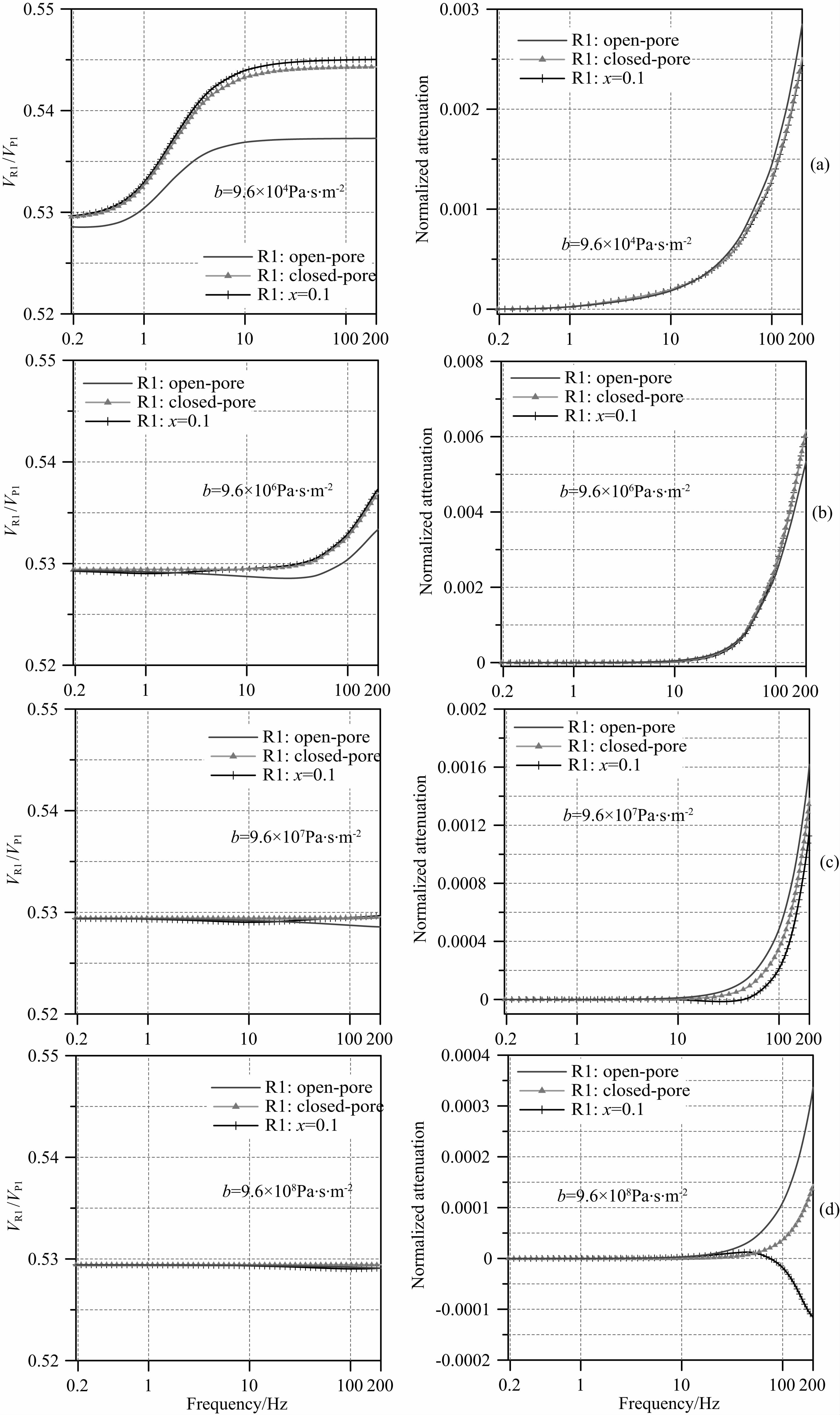 |
图 2 不同固流耦合系数时R1波的相速度和衰减系数频散 Fig. 2 Phase velocity and attenuation coefficient of R1 wave for different solid-fluid coupling coefficients |
 |
图 3 不同固流耦合系数时R2波的相速度和衰减系数频散 Fig. 3 Phase velocity and attenuation coefficient of R2 wave for different solid-fluid coupling coefficients |
进一步计算在垂直于自由表面应力源下面波的地震动响应,集中力点震源方程为

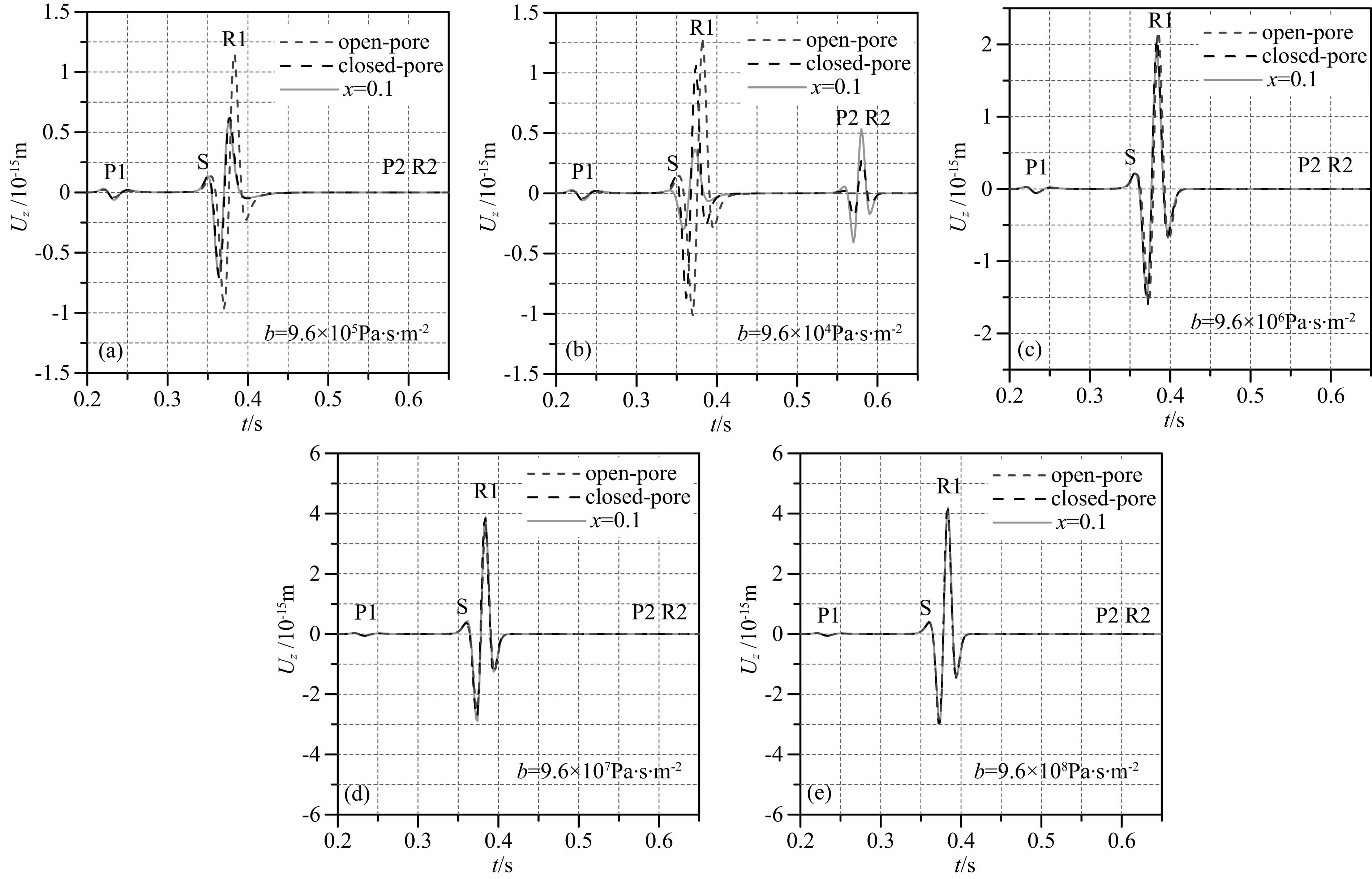 |
图 4 不同固流耦合系数时面波的地震动响应 Fig. 4 Seismic responses of surface wave for different solid-fluid coupling coefficients |
Berryman(1980)给出由孔隙度估计孔隙迂曲度的公式,

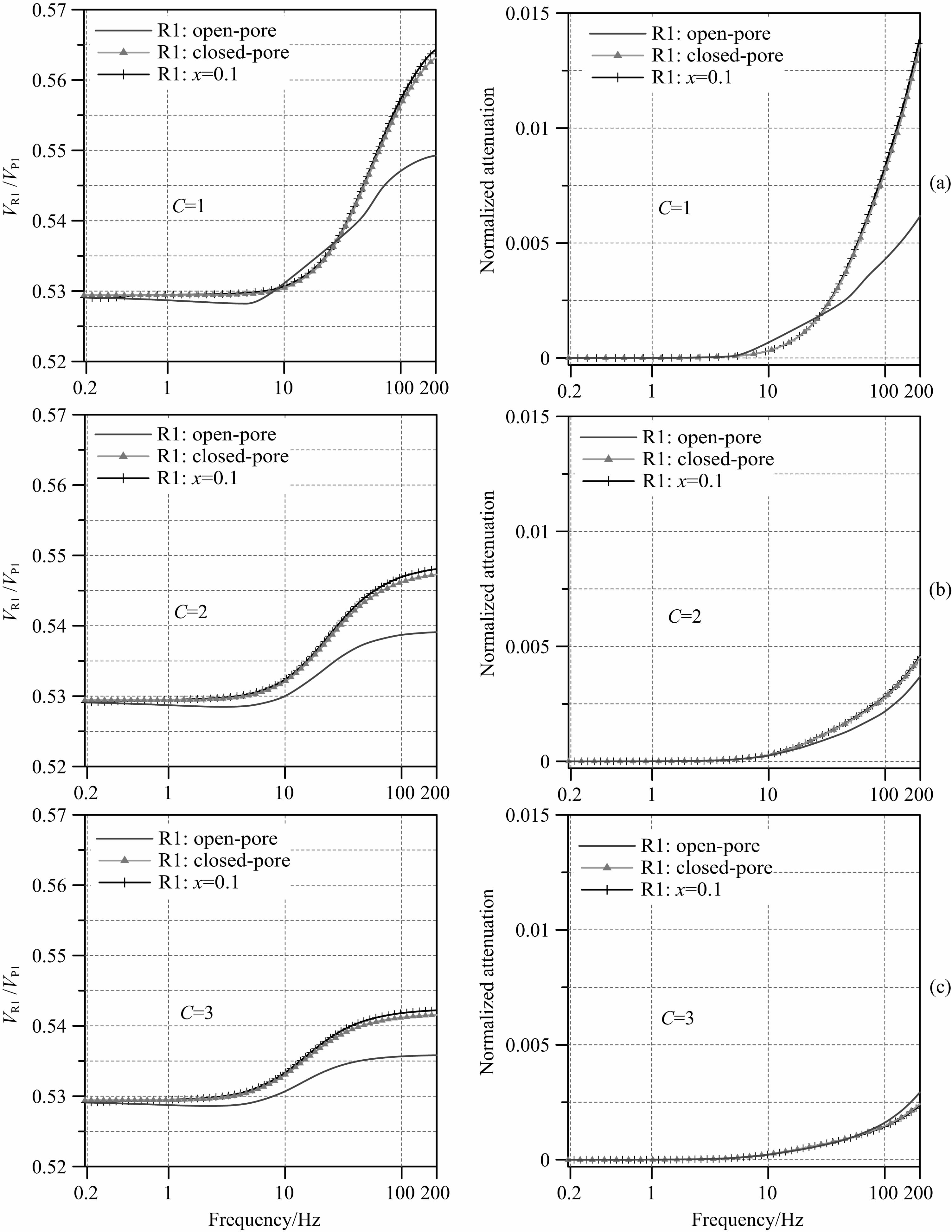 |
图 5 不同孔隙迂曲度时R1波的相速度和衰减系数频散 Fig. 5 Phase velocity and attenuation coefficient of R1 wave for different tortuosities |
 |
图 6 不同孔隙迂曲度时R2波的相速度和衰减系数频散 Fig. 6 Phase velocity and attenuation coefficient of R2 wave for different tortuosities |
图 7所示与图 4相同震源和接收参数时,迂曲度为1、2、3时面波地震动响应特征.孔隙迂曲度较小时,R1波振幅最弱,随着C的增加,R1波振幅增强.参照P1波,迂曲度变化时,三种流体边界下波形和振幅差异较小,说明P1波受孔隙流体的影响较R1波小.R2波没有观察到.
 |
图 7 不同孔隙迂曲度下面波的地震动响应 Fig. 7 Seismic responses of surface wave for different tortuosities |
由于浅地表岩石的固结程度低,某些软弱土层中面波速度很低.这时,震源激发的速度会对面波地震动响应造成明显的影响.含流体孔隙介质在移动 震源激发下的动态响应是重要的工程问题,如Burke和Kingsbury(1984)给出在地表移动压力下孔隙介质响应的解析解.Siddharthan等(1993)忽略固流耦合,分析平面应变下移动载荷下多层孔隙介质响应.Jin等(2004)获得地表匀速线载荷下的二维介质响应的半解析表达.Theodorakopoulos(2003),Theodorakopoulos等(2004)通过移动线载荷的解析和近似数值方法研究二维土壤介质的响应.Lu和Jeng(2007)首次推导匀速点载荷下的三维孔隙介质的动态响应.Xu等(2008)进一步扩展到多层的情况.Cai等(2007,2008)研究有限矩形载荷和轨道系统下,骨架不可压缩时三维稳态响应.Cao和BostrÖm(2013)研究加速和减速的火车载荷轨道系统激发的孔隙介质响应特征.Lefeuve-Mesgouez和Mesgouez(2008,2012)通过波模态分析半空间及多层孔隙黏弹性介质在高速谐振矩形载荷下的地震动传播过程.Li等(2012)分析孔隙介质的波数域近似解表示移动谐振下半空间响应的精度.Beskou和Theodorakopoulos(2011)全面回顾移动激发问题.稳态载荷(单色频率)过于简单,不能有效利用振动响应包含面波传播的有效信号.将移动载荷视为有限频率噪声源,并考虑流体自由表面边界效应,分析激发的面波传播特征可以更充分认识移动震源效应的影响.
软弱孔隙介质参数见表 2,对应某一高速公路施工现场采集的未固结砂岩样本.该样本有较低的剪切模量和较高的渗透率,反映浅表含水层的典型地质条件.流体对应浅地表水的状况.选择沿x轴方向以速度v移动的地表点应力震源,可以写成

| 表 2 软弱孔隙介质物性参数 Table 2 Model properties of a weakly porous medium |
对比方程(3),加入震源速度的扰动,作坐标参数替换x′=x-vt.震源幅度为100 N,震源过坐标原点时开始计时,时间响应仍为Ricker子波,时移0.05 s,接收点在(30 m,30 m,1 m)处(图 8).选择低主频5 Hz震源突出震源移动的影响(Zhang et al.,2014a).图 9所示三种流体自由表面(开放孔隙、闭合孔隙以及渗透刚度0.1时部分疏通情况)下垂直位移和孔隙流体压力的面波地震动响应.表 2对应等效Gassmann介质Rayleigh波速度约为169 m·s-1,移动震源速度选择从亚Rayleigh波速度(40 m·s-1)到超Rayleigh波速度(200 m·s-1).只有P1和R1波可以分辨.震源速度增大到169 m·s-1,所有波形明显压缩.震源速度进一步增大到200 m·s-1,这些现象更为明显.这源于Doppler蓝移,由径向视速度产生(图 8).图 10比较开放孔隙 时垂直位移和流体压力在震源速度v为40 m·s-1和200 m·s-1 时功率谱.相比v=40 m·s-1,v=200 m·s-1时频率成分有明显的上移,无论垂直位移还是流体压力,主频甚至大于10 Hz,比震源原始主频5 Hz大1倍.移动震源的Doppler效应对面波传播频率响应有明显影响.波形扭曲出现,特别是R1波,表现为子波拖长.这源于横向速度(图 8).主 频较低(5 Hz),子波时长大概0.2 s(T≈1/5=0.2 s),移动震源激发时有明显的横向移动.
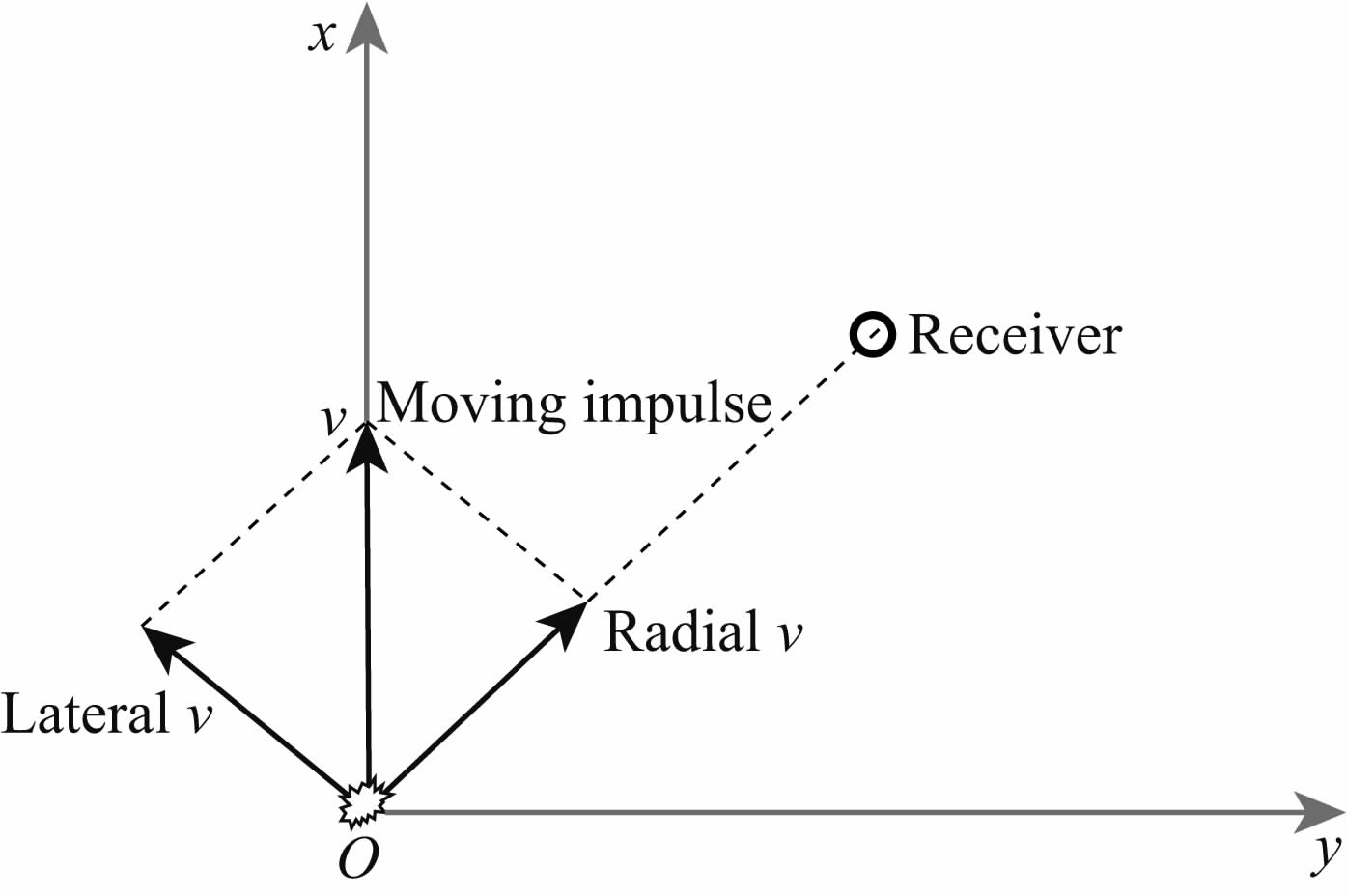 |
图 8 xy平面内以匀速v沿x运动的移动震源和接收点的相对位置 Fig. 8 The decomposition of the velocity of the moving impulse along x axis related to the receiver on the xy plane |
 |
图 9 不同震源移动速度下固体垂直位移和孔隙流体压力的面波地震动响应 Fig. 9 Seismic responses of solid vertical displacement and pore fluid pressure for different source velocities |
 |
图 10 震源移动速度为40 m·s-1和200 m·s-1时固体垂直位移(a)和孔隙流体压力(b)面波地震动的功率谱 Fig. 10 Power spectra of solid vertical displacement(a) and pore fluid pressure(b) of surface wave seismic responses for source velocities at 40 m·s-1 and 200 m·s-1 |
孔隙中流体的特性会极大地影响介质中波动传播.通常情况,孔隙空间内通常是气体和液体混合充填的,这时在地震频带内Biot宏观固流耦合效应难以解释观测到的衰减.有研究表明(Pride et al.,2004),中观尺度的流体斑块饱和是造成波动衰减的主要因素.这种机制由于中观尺度下波动激发的流体流动造成.White(1975)最早建立分离的球状气体饱和斑块和液体饱和背景模型来描述这一特征.波动造成的流体压力梯度使气饱和斑块扩散形变,驱动斑块和背景间的流体对流,导致介质的本征衰减(Johnson,2001; Vogelaar et al.,2010).这一低频的部分饱和效应已在体波研究中得到广泛重视.观测资料和数值模拟也与这种斑块饱和模型一致(Wenzlau and Müller,2009),波动激发的对流改变介质整体的频率响应(Saenger et al.,2009).面波由体波干涉而成,斑块饱和这一机制必然会影响面波.进一步理解斑块饱和对面波的影响可以使我们更精确估计面波波速和衰减,建立更精确反演成像模型.
中观尺度(典型值为数十厘米)远大于孔隙尺度,又远小于波长.因此,在中观尺度上,波动激发的流体压力变化在一个波动周期内不能完全平衡.非均匀的斑块饱和经常产生于气液接触区域.在完全气饱和及完全液饱和区域之间,通常会有一转换区域存在.波动激发的对流会在这一区域内造成压力梯度,并驱使气流接触面的扩散效应(Pride and Berryman,2003).
斑块饱和模型用于描述可压缩孔隙介质中包含一种液体,及一些气体饱和斑块(半径a).通常各气体饱和斑块之间的相互作用被忽略.假设每一个斑块之外有一个液体饱和的壳(半径b),气体部分占S1=a3/b3,且S2=1-S1为液体所占比例.半径b满足整个球体的体积 4/3 πb3等于每一单元立方体的体积(图 11).波动在该介质模型传播时,会造成不同流体接触面的扰动,低频时流体能在波周期内达到压力平衡(松弛状态),区域内流体压力一致.流体等效体积模量由Reuss平均给出(White,1975; Johnson,2001)


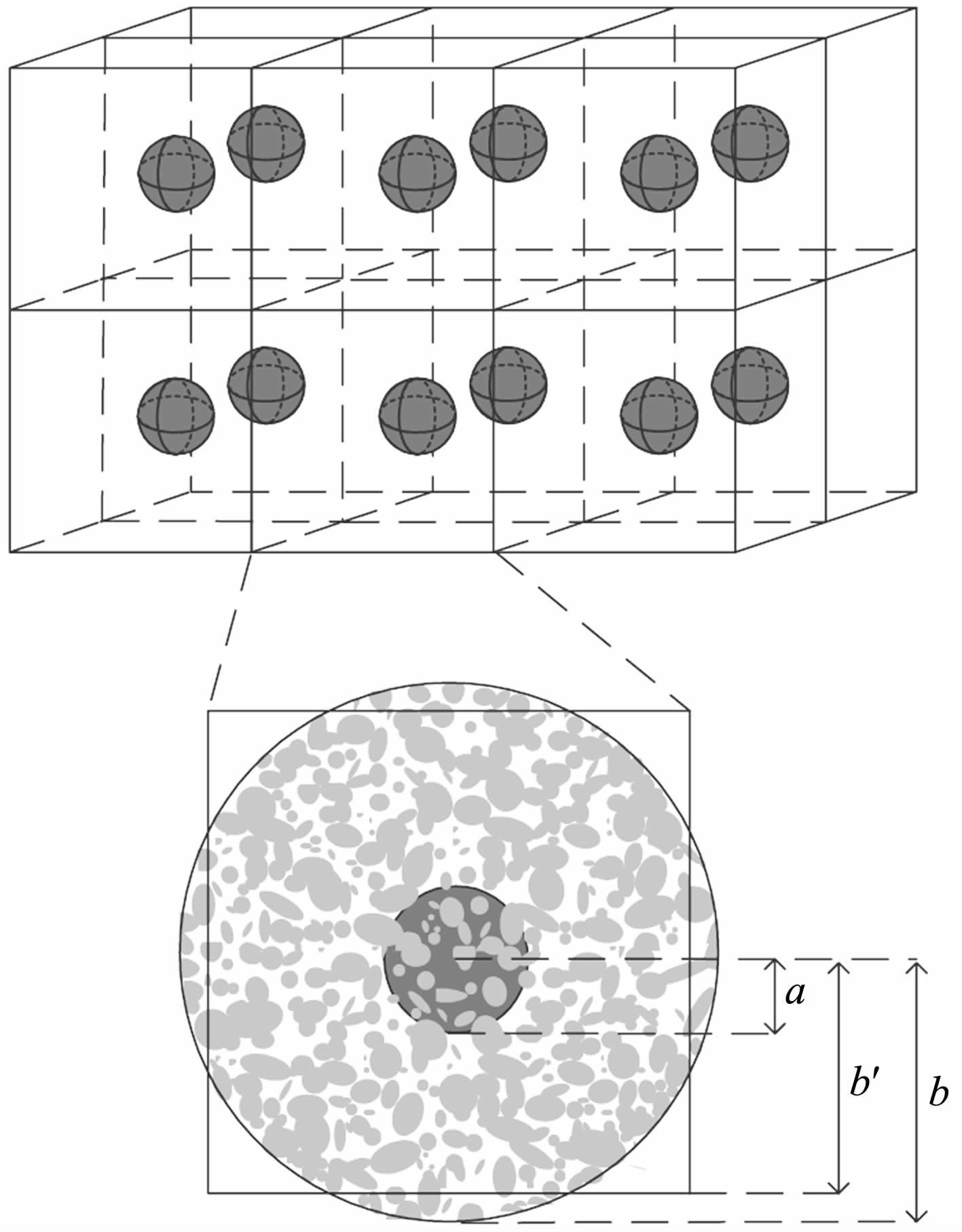 |
图 11 由周期性的半径为a,相隔距离为2b′的球状气体 饱和区域构成的立方体格子,改自Vogelaar et al.,2010 每一气体饱和区域由一个外半径为b的液体饱和的球壳包围,所以立方体格子的体积等于同心球体的体积,即Vb′= Vb. Fig. 11 Geometry of the cubic lattice of periodic spherical gas pocket with radius a,separated by distance 2b′(from Vogelaar et al.,2010) Each gas pocket is surrounded by a liquid shell with radius b,so that the volume of the cube equals to the volume of the sphere Vb′=Vb. |
频率足够高,波周期内流体不能完全松弛,造成流体的压力梯度.区域内的流体压力不一致,但仍可假设各个流相中的压力一定.介质的体积模量可以通过Hill理论给出.



在两极限频率之间的转换反映斑块饱和模型中波动的频率响应,体现中观机制的影响.White(1975)的处理方法(Dutta和Seriff(1979)修正)获取这一模型复频率效应.Johnson(2001)推广White模型得到因果性的近似广义解.Vogelaar等(2010)进一步给出精确解.
斑块饱和介质性质如表 3所示.同心球壳的外半径为b=20 cm,代表斑块的尺度.整个斑块饱和介质源自XH高速公路附近采集的空气-水饱和未固结含砂粘土样本.
| 表 3 斑块饱和孔隙介质的物性参数 Table 3 Model properties of a patchy saturated porous medium |
图 12a显示多相流体斑块饱和介质中频散的P1波相速度和衰减(1/Q).其中气体占流体比例为0.3.在低频端P1波接近静态极限;在高频端P1波 接近非流动极限.两极限之间的转换在地震频带内显现(1~200 Hz),这也解释了这一频带内波动传播的主要衰减.可以发现方程fm=Kf2k/2πη2ϕ(b-a)2(图中垂直点线)给出近似的转换特征频率(Dutta and Serriff,1979),这一频率也区分松弛和非松弛状态.但需要注意,这一机制在Biot理论框架内对S波影响较小,因为两种极限对于S波来说相互重合.这一结论,亦被数值模拟验证(Rubino et al.,2009; Liu et al.,2009a).
 |
图 12 P1波(a)和R1波(b)在斑块饱和模型中的相速度和衰减频散特征.S1=0.3,b=0.2 m 上下水平线表示两极限频率下的体积模量KGW和KGH.垂直的点线近似表示转换特征频率. R1波衰减的对照组代表气饱和和水饱和时的情况. Fig. 12 Phase velocities and attenuation of P1 wave(a) and R1 wave(b)in the patchy saturation model. S1=0.3,b=0.2 m The lower and upper horizontal lines are obtained from limiting modulus KGW and KGH. The vertical dot line is the approximating transition frequency. The control groups for R1 attenuation represent the half space fully saturated by air and water. |
宏观上描述该模型的自由表面边界效应,可以用等效复体积模量表征的边界条件来获取Rayleigh面波的久基方程和地震动动态响应(Zhang et al.,2014b).选择和体波分析一致的介质模型,面波频 散的相速度和衰减如图 12b所示.斑块饱和衰减同样在低频段的面波频散中显现,与P1波类似(图 12a).转换也在两个频率极限——静态极限和非流动极限之间出现(图 12b左).衰减1/Q较水饱和和气饱和下明显增强.对应最大1/Q转换特征频率在数十赫兹内显现,落入地震频带内,也与P1波类似(图 12a右).因为S波受流体分布影响较小,面波的这一趋势主要反映P1的影响.虽然面波相对P1波的敏感性不如S波显著(Xia et al.,1999),但低频段内P1波的影响不能被忽略.Biot机制特征频率很高,可以推断在低频带内,斑块饱和衰减机制对面 波的衰减有显著的影响.因而必须小心建立面波的 衰减模型,同时强调频率依赖和P1波的影响.
面波的地震动响应也反映这一特征(图 13),其中震源为Ricker子波,主频35 Hz,时移0.1 s,幅度100 N,偏移距200 m.可以看到顾及斑块饱和机制 的面波如P1波一样,比水饱和气饱和仅有Biot宏 观机制时振幅明显衰减.
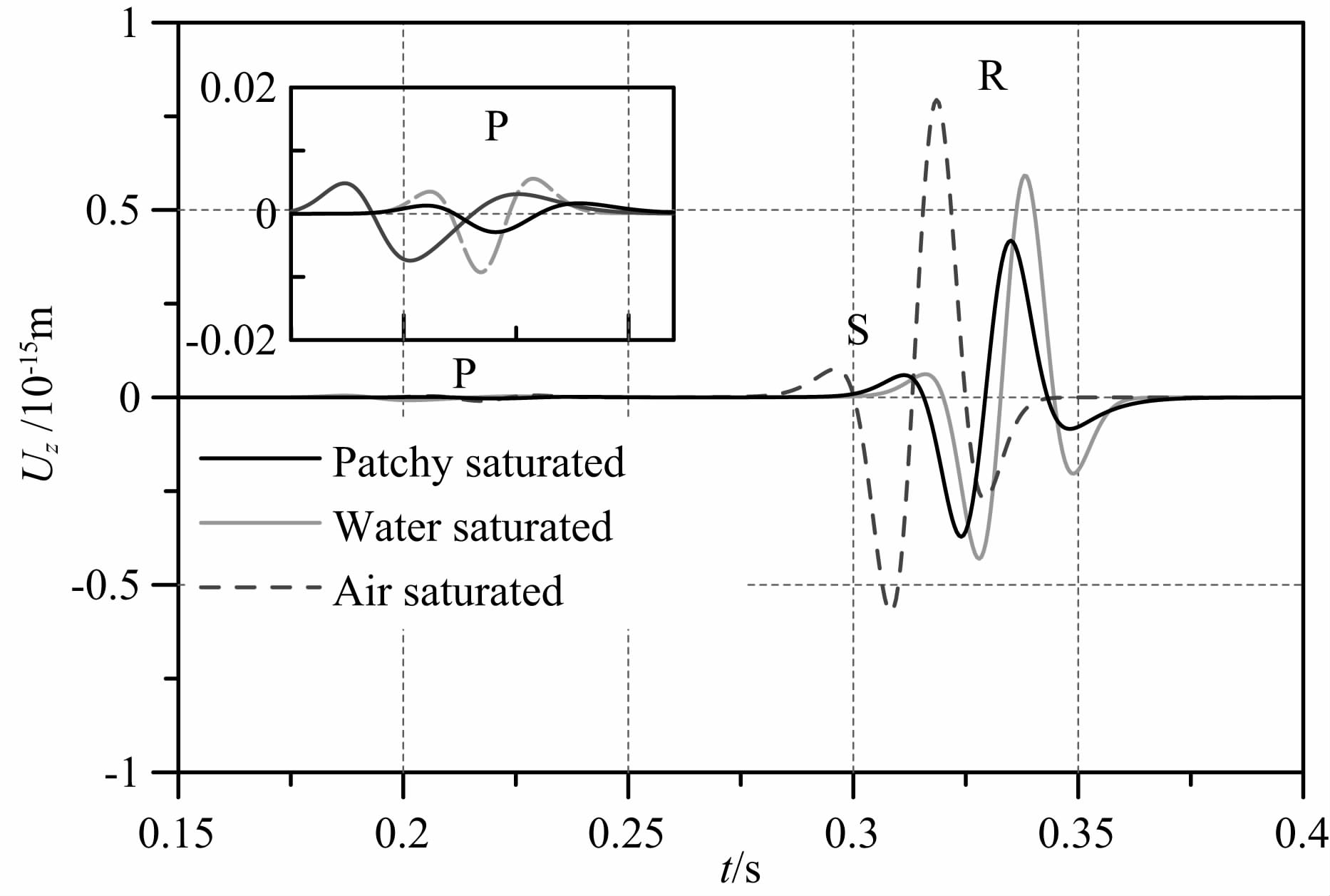 |
图 13 面波在斑块饱和模型中的地震动响应.S1=0.3,b=0.2 m 对照组代表气饱和水饱和时的情况. Fig. 13 Seismic responses of surface wave in the patchy saturation model. S1 = 0.3 and b=0.2 m The control groups represent the half space fully saturated by air and water. |
数值实验还发现,这一中观尺度上的面波衰减与气体在流体中的比例有很明显的关系,也为利用面波探测地下流体分布提供可能(Zhang et al.,2014b).
5 面波传播的等效特征P2波在低频段速度低,且具有很强的扩散性质,造成Biot波动方程数值计算时很不稳定,需要很大的存储量和计算时间(Carcione and Quiroga-Goode,1995,1996).为克服这些困难,找到孔隙介质中波动传播的等效解是有效手段.应用黏弹性等效单元模拟宏观固流耦合效应研究体波传播最早见于Geertsma和Smit(1961)的研究.P1波的品质因 子(Q)满足Q>5,孔隙介质中的衰减可用一单元的标准线性体(Zener体)等效表示(Ben-Menahem and Singh,1981).Carcione(1998)成功地应用Zener等效固体表征Biot宏观流和喷流机制(Dvorkin et al.,1994).并成功模拟包含P波和S波的等效波场,建立记忆变量等效代替.虽然Biot的宏观流机制不涉及固体的体形变,但是用Zener模型,可直接匹配每一种波型的频散和衰减(Carcione,1998).这种等效模型也用来描述波动散射的问题(Morochnik and Bardet,1996).最近的研究表明,这种等效模型也可以用来表述部分饱和(Rubino et al.,2009; Picotti et al.,2010,2012a; Carcione et al.,2012)、双孔隙(Liu et al.,2009b,2010),以及多相固体等提升Biot模型(Picotti et al.,2012b).这些研究表明,复杂介质可用简单的等效介质表征,等效黏弹性固体中用松弛函数直接匹配每一种波型可以有效地表征孔隙介质中波动传播的宏观特征(Carcione,2007).由于自由表面的存在,Rayleigh面波的数值计算方法面临更为严苛的不稳定问题,即便是在完全弹性固体中,需要在很小的网格中求解差分方程(Xu et al.,2007; Zeng et al.,2011).流体自由表面会使面波特征更为复杂(Zhang et al.,2011,2012),数值计算的稳定性更差.这也为实际面波应用中引入多相孔隙模型带来困难.因此,在前人用等效固体表征体波的同时,我们也需要回答包含自由界面效应的面波是否也可用等效黏弹性固体表征.
基于含流体孔隙介质模型,等效黏弹性模型可由黏弹性单元替代原本构方程中的复模量实现(Carcione,2007).在单相的黏弹性模型中,体波可以等效地用速度和衰减相关的松弛模式等效表征.Rayleigh面波也可以用包含两种体波松弛模式的黏弹性固体结合边界条件实现.
使用标准线性体模型(Zener模型)来表征快波(P1波和S波),Zener黏弹性单元的复模量可以表示成(Carcione,2007)


面波的等效相速度和1/Q亦可通过求解等效介质中Rayleigh面波的久基方程求得,相应的面波地震动响应可以通过类似的积分变换方法得到.
图 14显示低频带未固结砂岩(表 2)在孔隙中充填水和空气时Rayleigh面波的频散曲线.孔隙含水时,孔隙介质的特征频率  为638.5 Hz.Zener模型拟合的P1波的衰减峰值频率为f0P=436.9 Hz,相应的品质因子为Q0P=17.5;S波的衰减峰值频率为f0S=421.0 Hz,相应的品质因子为Q0S=13.3.在频率接近及大于fc时,可以发现频散曲线明显的差异.虽然等效黏弹性固体在表征体波时,全频带内有很好的一致性(Carcione,1996; Picotti et al.,2010),但并不能表征Rayleigh面波速度频散在低频的局部极值,而这一极值恰恰源于P2波扰动.在这一频率内,黏弹性固体也低估Rayleigh面波的衰减.未固结砂岩渗透率很高,造成P2波f1/2频率响应的扩散效应的频带变窄,使P2波在地震频带内以较高的速度传播(Zhang et al.,2011).这一现象加强Rayleigh面波的衰减(图 14a),而等效黏弹性固体不能反映这一点.孔隙含空气时,孔隙介质的特征频率fc为9549.3 Hz.Zener 模型拟合的P1波的衰减峰值频率为f0P=1.2489× 104 Hz,相应的品质因子为Q0P=4488.5;S波的衰减峰值频率为f0S=5840.9 Hz,相应的品质因子为Q0S=9200.6.这种情况下,速度频散变得不明显,衰减也非常弱.等效黏弹性介质在速度和衰减上显示出与孔隙介质很好的一致性.
为638.5 Hz.Zener模型拟合的P1波的衰减峰值频率为f0P=436.9 Hz,相应的品质因子为Q0P=17.5;S波的衰减峰值频率为f0S=421.0 Hz,相应的品质因子为Q0S=13.3.在频率接近及大于fc时,可以发现频散曲线明显的差异.虽然等效黏弹性固体在表征体波时,全频带内有很好的一致性(Carcione,1996; Picotti et al.,2010),但并不能表征Rayleigh面波速度频散在低频的局部极值,而这一极值恰恰源于P2波扰动.在这一频率内,黏弹性固体也低估Rayleigh面波的衰减.未固结砂岩渗透率很高,造成P2波f1/2频率响应的扩散效应的频带变窄,使P2波在地震频带内以较高的速度传播(Zhang et al.,2011).这一现象加强Rayleigh面波的衰减(图 14a),而等效黏弹性固体不能反映这一点.孔隙含空气时,孔隙介质的特征频率fc为9549.3 Hz.Zener 模型拟合的P1波的衰减峰值频率为f0P=1.2489× 104 Hz,相应的品质因子为Q0P=4488.5;S波的衰减峰值频率为f0S=5840.9 Hz,相应的品质因子为Q0S=9200.6.这种情况下,速度频散变得不明显,衰减也非常弱.等效黏弹性介质在速度和衰减上显示出与孔隙介质很好的一致性.
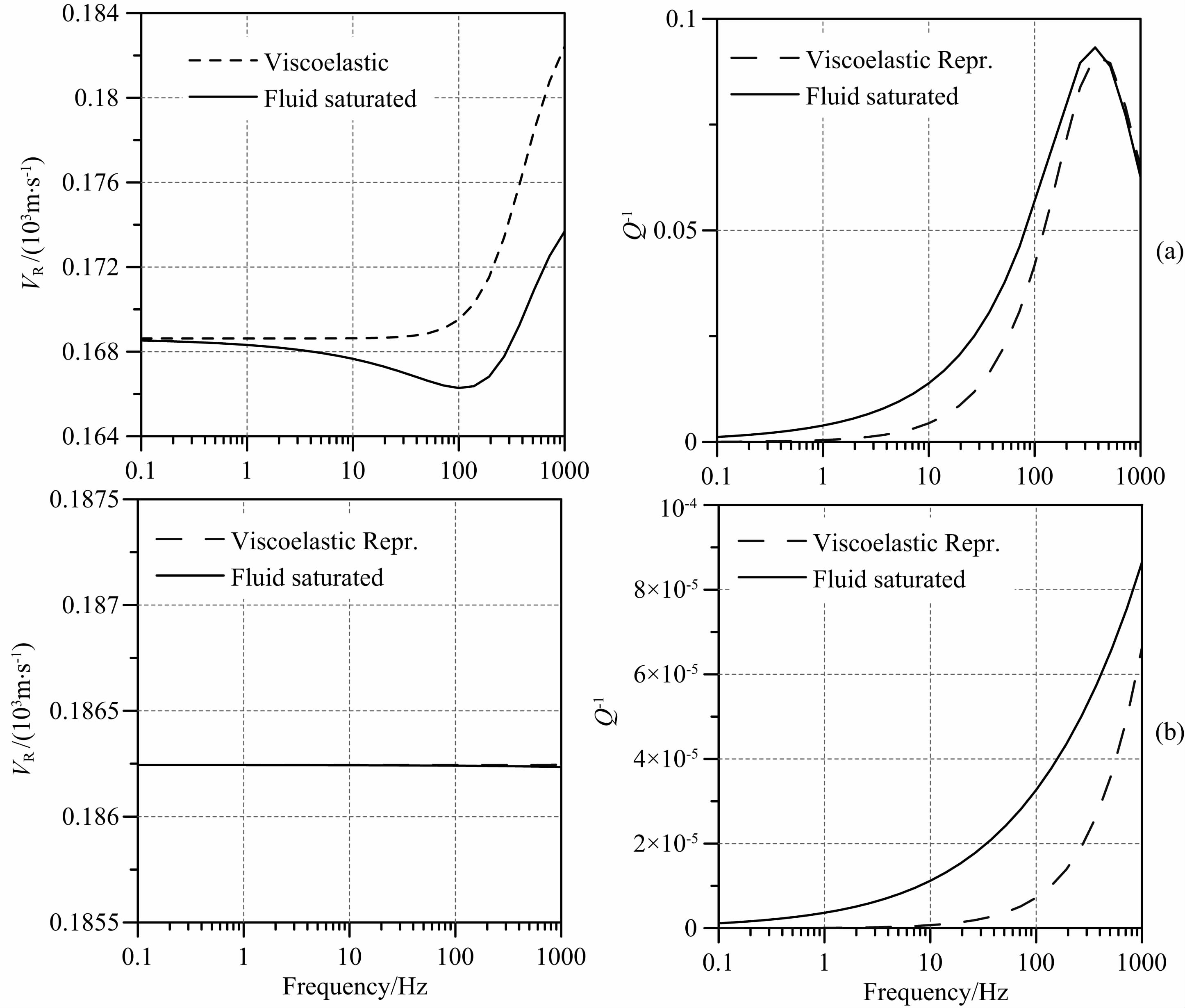 |
图 14 面波在未固结砂岩中相速度(左)和衰减(右)的频散 孔隙中充填水(a)和空气(b).两种等效黏弹性固体中快波的衰减峰值频率和品质因子分别为436.9 Hz,421.0 Hz和17.5,13.3(a), 以及12488.5 Hz,5840.9 Hz和4488.5,9200.6(b).孔隙含水的情况下,等效介质在低频段低估面波的衰减. Fig. 14 The dispersion of phase velocity(left) and attenuation(right)of surface wave in the unconsolidated s and for water(a) and air(b)saturated models The two equivalent-viscoelastic materials have relaxation frequency of 436.9 Hz,421.0 Hz and quality factor of 17.5,13.3 for the two body wave modulus for the water case(a),and relaxation frequency of 12488.5 Hz,5840.9 Hz and quality factor of 4488.5,9200.6 for the air case(b),respectively. The effective representation underestimated the attenuation for the water case at low frequencies. |
图 15 面波在未固结砂岩中的等效地震动响应波形 孔隙中充填水(a)和空气(b).震源激发的主频分别为5 Hz(左)、50 Hz(中)和200 Hz(右). 除50 Hz和200 Hz孔隙含水时(a),等效介质中波形显示出与孔隙介质相当好的一致性.
图 15所示未固结砂岩中面波的垂直位移地震动响应.接收点位于自由表面,偏移距为100 m.时移0.1 s的Ricker子波震源的主频fs分别为5 Hz(左)、50 Hz(中)和200 Hz(右).在孔隙含水时(图 15a),震源主频为50 Hz和200 Hz时,等效黏弹性介质未能拟合孔隙介质中的波形.而在fs=5 Hz则显示出相当好的拟合效果.而在孔隙含空气时(图 15b),所有结果都显示出较好的一致性.
 |
图 15 中文标题 Fig. 15 Seismic responses of surface wave in the unconsolidated s and for water(a) and air(b)saturated models The source pulses have center frequency of 5 Hz(left),50 Hz(center),and 200 Hz(right). Except for 50 Hz and 2 00 Hz for water case(a),the wave forms show a fairly well match with the fluid-saturated model. |
含多相流体的孔隙介质,由于P1、P2波的共同作用造成中观尺度下对流,引起波传播的衰减,也可以直接对等效体积模量以及S波做黏弹性等效替换,得到类似的等效表征模型(Zhang et al.,2014d).
6 结论及展望精确认识面波在真实介质传播时的速度和衰减特征是提高面波方法勘探精度的基础.本文从面波的几个方面详细讨论了面波在更接近实际介质的孔隙介质模型中的传播特性,获得以下几点认识:
(1)流体在自由表面不同行为造成面波传播的差异使得在面波的数据采集和处理时,根据不同地表条件引入流体自由表面效应的修正.特别是针对浅地表岩石固结程度低、渗透率较高的情况.有些特殊情况甚至要考虑第二模式面波的影响.这种修正的方法和评价标准,需要再结合实际情况进一步的研究.
(2)针对浅地表介质软弱,面波速度较低的情况,震源激发时移动速度有时候也需要评价.相对于观测点的径向、横向移动会造成面波信号频率响应的明显变化,特别是震源激发频率较低时.在有着较高速度移动噪声源的环境中,这种效应的影响需要根据采集观测系统和主要噪声源的方位判断.扰动的影响的大小需要根据实际采集环境谨慎地评价.
(3)当介质部分饱和时,中观尺度多相流体的斑块饱和效应会在地震探测频带内显著影响面波的传播.这一机制主要影响胀缩运动的P波,故而在地震频带内估计面波的衰减,需要重新重视P波的影响.
(4)根据面波的传播特征建立等效黏弹性模型,在地震探测频带内能较好地表征面波在孔隙介质中的传播,这有利于在面波的数值计算中更经济地引入孔隙介质模型,建立更少参数约束的面波反演成像模型.
可以发现,含流体的孔隙介质中面波的传播较弹性介质更为复杂.在面波实际应用中顾及复杂传播特性影响的研究尚在起步阶段,如何更合理有效地引入孔隙介质模型,有更多的理论实际问题需要进一步探讨.
致谢 感谢匿名审稿人对本文的建议.
| [1] | Aki K, Richards P G. 1980. Quantitative Seismology. San Francisco: Freeman. |
| [2] | Albers B, Wilmanski K. 2005. Monochromatic surface waves on impermeable boundaries in two-component poroelastic media. Continuum Mechanics and Thermodynamics, 17(3): 269-285, doi: 10.1007/s00161-005-0203-y. |
| [3] | Ben-Menahem A, Singh S G. 1981. Seismic Waves and Sources. New York: Springer-Verlag. |
| [4] | Berryman J G. 1980. Confirmation of Biot's theory. Appl. Phys. Lett., 37(4): 382-384, doi: 10.1063/1.91951. |
| [5] | Beskou N D, Theodorakopoulos D D. 2011. Dynamic effects of moving loads on road pavements: A review. Soil Dyn. Earthq. Eng., 31(4): 547-567, doi: 10.1016/j. soildyn.2010.11.002. |
| [6] | Biot M A. 1941. General theory of three-dimensional consolidation. J. Appl. Phys., 12(2): 155-164, doi: 10.1063/1.1712886. |
| [7] | Biot M A. 1956. Theory of propagation of elastic waves in a fluid-saturated porous solid. I. Low-frequency range. J. Acoust. Soc. Am., 28(2): 168-178, doi: 10.1121/1.1908239. |
| [8] | Biot M A. 1962. Mechanics of deformation and acoustic propagation in porous media. J. Appl. Phys., 33(4): 1482-1498, doi: 10.1063/1.1728759. |
| [9] | Burke M, Kingsbury H B. 1984. Response of poroelastic layers to moving loads. Int. J. Solids Struct., 20(5): 499-511, doi: 10.1016/0020-7683(84)90015-5. |
| [10] | Cai Y Q, Sun H L, Xu C J. 2007. Steady state responses of poroelastic half-space soil medium to a moving rectangular load. Int. J. Solids Struct., 44(22-23): 7183-7196, doi: 10.1016/j.ijsolstr.2007.04.006. |
| [11] | Cai Y Q, Sun H L, Xu C J. 2008. Response of railway track system on poroelastic half-space soil medium subjected to a moving train load. Int. J. Solids Struct., 45(18-19): 5015-5034, doi: 10.1016/j.ijsolstr.2008.05.002. |
| [12] | Cao Z G, BostrÖm A. 2013. Dynamic response of a poroelastic half-space to accelerating or decelerating trains. J. Sound Vib., 332(11): 2777-2794, doi: 10.1016/j.jsv.2012.12.015. |
| [13] | Carcione J. 2007. Wave Fields in Real Media: Wave Propagation in Anisotropic, Anelastic, Porous and Electromagnetic Media. 2nd ed. Amsterdam: Elsevier. |
| [14] | Carcione J M, Quiroga-Goode G. 1995. Some aspects of the physics and numerical modeling of Biot compressional waves. J. Comput. Acoust., 3(4): 261-280, doi: 10.1142/S0218396X95000136. |
| [15] | Carcione J M, Quiroga-Goode G. 1996. Full frequency-range transient solution for compressional waves in a fluid-saturated viscoacoustic porous medium. Geophys. Prospect., 44: 99-129, doi: 10.1111/j.1365-2478.1996.tb00141.x. |
| [16] | Carcione J M. 1998. Viscoelastic effective rheologies for modelling wave propagation in porous media. Geophys. Prospect., 46(3): 249-270, doi: 10.1046/j.1365-2478.1998.00087.x. |
| [17] | Carcione J M, Gei D, Picotti S, et al. 2012. Cross-hole electromagnetic and seismic modeling for CO2 detection and monitoring in a saline aquifer. J. Petrol. Sci. Eng., 100: 162-172, doi: 10.1016/j.petrol.2012.03.018. |
| [18] | Deresiewicz H. 1962. The effect of boundaries on wave propagation in a liquid-filled porous solid. IV. Surface waves in a half-space. Bull. Seismol. Soc. Am., 52(3): 627-638. |
| [19] | Deresiewicz H, Skalak R. 1963. On uniqueness in dynamic poroelasticity. Bull. Seismol. Soc. Am., 53(4): 783-788. |
| [20] | Dutta N C, Seriff A J. 1979. On White's model of attenuation in rocks with partial gas saturation. Geophysics, 44(11): 1806-1812, doi: 10.1190/1.1440940. |
| [21] | Dvorkin J, Nolen-Hoeksema R, Nur A. 1994. The squirt-flow mechanism: macroscopic description. Geophysics, 59(3): 428-438, doi: 10.1190/1.1443605. |
| [22] | Edelman I, Wilmanski K. 2002. Asymptotic analysis of surface waves at vacuum/porous medium and liquid/porous medium interfaces. Continuum Mechanics and Thermodynamics, 14(1): 25-44, doi: 10.1007/s001610100069. |
| [23] | Edelman I. 2004. Surface waves at vacuum/porous medium interface: low frequency range. Wave Motion, 39(2): 111-127, doi: 10.1016/j.wavemoti.2003.07.004. |
| [24] | Geertsma J, Smit D C. 1961. Some aspects of elastic wave propagation in fluid-saturated porous solids. Geophysics, 26(2): 169-181, doi: 10.1190/1.1438855. |
| [25] | Gerasik V, Stastna M. 2014. Pseudo-interface Rayleigh wave on a permeable porous medium/vacuum interface. J. Acoust. Soc. Am., 135(5): 2625-2633, doi: 10.1121/1.4869692. |
| [26] | Halpern M R, Christiano P. 1986. Response of poroelastic halfspace to steady-state harmonic surface tractions. Int. J. Nemer. Anal. Meth. Geomech., 10(6): 609-632, doi: 10.1098/rspa.2007.0107. |
| [27] | Jin B, Yue Z Q, Tham L G. 2004. Stresses and excess pore pressure induced in saturated poroelastic halfspace by moving line load. Soil Dyn. Earthq. Eng., 24(1): 25-33, doi: 10.1016/j.soildyn.2003.09.004. |
| [28] | Johnson D L. 2001. Theory of frequency dependent acoustics in patchy-saturated porous media. J. Acoust. Soc. Am., 110(2): 682-694, doi: 10.1121/1.1381021. |
| [29] | Jones J P. 1961. Rayleigh wave in a porous elastic saturated solid. J. Acoust. Soc. Am., 33(7): 959-962, doi: 10.1121/1.1908865. |
| [30] | Lefeuve-Mesgouez G, Mesgouez A. 2008. Ground vibration due to a high-speed moving harmonic rectangular load on a poroviscoelastic half-space. Int. J. Solids Struct., 45(11-12): 3353-3374, doi: 10.1016/j.ijsolstr.2008.01.026. |
| [31] | Lefeuve-Mesgouez G, Mesgouez A. 2012. Three-dimensional dynamic response of a porous multilayered ground under moving loads of various distributions. Adv. Eng. Software, 46(1): 75-84, doi: 10.1016/j.advengsoft.2010.09.006. |
| [32] | Li S, Sun H L, Cai Y Q, et al. 2012. Validity of fully drained, fully undrained and u-p formulations for modeling a poroelastic half-space under a moving harmonic point load. Soil Dyn. Earthq. Eng., 42: 292-301, doi: 10.1016/j. soildyn.2012.06. 016. |
| [33] | Liu K, Liu Y. 2003. Characteristic of Rayleigh waves in transversely isotropic fluid-saturated porous media. Acta Mechanica Sinica (in Chinese), 35(1): 100-104. |
| [34] | Liu X, Greenhalgh S, Zhou B. 2009a. Scattering of plane transverse waves by spherical inclusions in a poroelastic medium. Geophys. J. Int., 176(3): 938-950, doi: 10.1111/j.1365-246X.2008.04026.x. |
| [35] | Liu X, Greenhalgh S, Zhou B. 2009b. Transient solution for poro-viscoacoustic wave propagation in double porosity media and its limitations. Geophys. J. Int., 178(1): 375-393. |
| [36] | Liu X, Greenhalgh S, Zhou B. 2010. Approximating the wave moduli of double porosity media at low frequencies by a single Zener or Kelvin-Voigt element. Geophys. J. Int., 181(1): 391-398, doi: 10.1111/j.1365-246X. 2009.04144.x. |
| [37] | Lu J F, Jeng D S. 2007. A half-space saturated poro-elastic medium subjected to a moving point load. Int. J. Solids Struct., 44(2): 573-586, doi: 10.1016/j.ijsolstr.2006.05.020. |
| [38] | Luo Y H, Xia J H, Liu J P, et al. 2007. Joint inversion of high-frequency surface waves with fundamental and higher modes. J. Appl. Geophys., 62(4): 375-384, doi: 10.1016/j.jappgeo.2007.02.004. |
| [39] | Luo Y H, Xia J H, Miller R D, et al. 2008a. Rayleigh-wave dispersive energy imaging using a high-resolution linear Radon transform. Pure Appl. Geophys., 165(5): 903-922, doi: 10.1007/s00024-008-0338-4. |
| [40] | Luo Y H, Xia J H, Liu J P, et al. 2008b. Generation of a pseudo-2D shear-wave velocity section by inversion of a series of 1D dispersion curves. J. Appl. Geophys., 64(3-4): 115-124, doi: 10.1016/j.jappgeo.2008.01.003. |
| [41] | Luo Y H, Xia J H, Liu J P, et al. 2009a. Research on the middle-of-receiver-spread assumption of the MASW method. Soil Dyn. Earthq. Eng., 29(1): 71-79, doi: 10.1016/j.soildyn.2008.01.009. |
| [42] | Luo Y H, Xia J H, Xu Y X, et al. 2009b. Dipping-interface mapping using mode-separated Rayleigh waves. Pure Appl. Geophys., 166(3): 353-374, doi: 10.1007/s00024-009-0451-z. |
| [43] | Mavko G, Mukerji T, Dvorkin J. 1998. The Rock Physics Handbook: Tools for Seismic Analysis of Porous Media. Cambridge: Cambridge University Press. |
| [44] | Misiek R, Liebig A, Gyulai A, et al. 1997. A joint inversion algorithm to process geoelectric and surface wave seismic data. Part II: application. Geophys. Prospect., 45(1): 65-85, doi: 10.1046/j.1365-2478.1997.3190241.x. |
| [45] | Morochnik V, Bardet J P. 1996. Viscoelastic approximation of poroelastic media for wave scattering problems. Soil Dyn. Earthq. Eng., 15(5): 337-346, doi: 10.1016/0267-7261(96)00002-4. |
| [46] | Paul S. 1976a. On the displacements produced in a porous elastic half-space by an impulsive line load. (Non-dissipative case). Pure Appl. Geophys., 114(4): 605-614, doi: 10.1007/BF00875654. |
| [47] | Paul S. 1976b. On the disturbance produced in a semi-infinite poroelastic medium by a surface load. Pure Appl. Geophys., 114(4): 615-627, doi: 10.1007/BF00875655. |
| [48] | Philippacopoulos A J. 1988. Lamb's problem for fluid-saturated, porous media. Bull. Seismol. Soc. Am., 78(2): 908-923. |
| [49] | Picotti S, Carcione J M, Rubino J G, et al. 2010. A viscoelastic representation of wave attenuation in porous media. Comp. Geosci., 36(1): 44-53, doi: 10.1016/j.cageo.2009.07.003. |
| [50] | Picotti S, Carcione J M, Gei D, et al. 2012a. Seismic modeling to monitor CO2 geological storage: The Atzbach-Schwanenstadt gas field. J. Geophys. Res., 117(6): B06103, doi: 10.1029/2011JB008540. |
| [51] | Picotti S, Carcione J M, Santos J E. 2012b. Oscillatory numerical experiments in finely layered anisotropic viscoelastic media. Comp. Geosci., 43: 83-89, doi: 10.1016/j.cageo.2012.02.026. |
| [52] | Plona T J. 1980. Observation of a second bulk compressional wave in a porous medium at ultrasonic frequencies. Appl. Phys. Lett., 36(4): 259-261, doi: 10.1063/1.91445. |
| [53] | Pride S R, Berryman J G. 2003. Linear dynamics of double-porosity dual-permeability materials. II. Fluid transport equations. Phys. Rev. E, 68: 036604. |
| [54] | Pride S R, Berryman J G, Harris J M. 2004. Seismic attenuation due to wave-induced flow. J. Geophys. Res., 109: B01201, doi: 10.1029/2003JB002639. |
| [55] | Rubino J G, Ravazzoli C L, Santos J E. 2009. Equivalent viscoelastic solids for heterogeneous fluid-saturated porous rocks. Geophysics, 74(1): N1-N13, doi: 10.1190/1.3008544. |
| [56] | Saenger E H, Schmalholz S, Lambert M, et al. 2009. A passive seismic survey over a gas field: Analysis of low-frequency anomalies. Geophysics, 74(2): O29-O40, doi: 10.1190/1.3078402. |
| [57] | Safani J, O'Neill A, Matsuoka T. 2006. Full SH-wavefield modelling and multiple-mode Love wave inversion. Exp. Geophys., 37(4): 307-321. |
| [58] | Senjuntichai T, Rajapakse R K N D. 1994. Dynamic Green’s functions of homogeneous poroelastic half-plane. J. Eng. Mech., 120(11): 2381-2404, doi: 10.1007/s00707-012-0720-2. |
| [59] | Siddharthan R, Zafir Z, Norris G M. 1993. Moving load response of layered soil. I. Formulation. J. Eng. Mech., 119(10): 2052-2071, doi: 10.1061/(ASCE)0733-9399(1993)119:10(2052). |
| [60] | Song X H, Gu H M, Liu J P, et al. 2007. Estimation of shallow subsurface shear-wave velocity by inverting fundamental and higher-mode Rayleigh waves. Soil Dyn. Earthq. Eng., 27(7): 599-607, doi: 10.1016/j.soildyn.2006.12.003. |
| [61] | Song Y Y, Castagna J P, Black R A, et al. 1989. Sensitivity of near-surface shear-wave velocity determination from Rayleigh and Love waves.//59th Ann. Internat Mtg., Soc. Expi. Geophys. Expanded Abstracts, 509-512. |
| [62] | Tajuddin M. 1984. Rayleigh waves in a poroelastic half-space. J. Acoust. Soc. Am., 75(3): 682-684, doi: 10.1007/s10659-012-9388-z. |
| [63] | Theodorakopoulos D D. 2003. Dynamic analysis of a poroelastic half-plane soil medium under moving loads. Soil Dyn. Earthq. Eng., 23(7): 521-533, doi: 10.1016/S0267-7261(03)00074-5. |
| [64] | Theodorakopoulos D D, Chassiakos A P, Beskos D E. 2004. Dynamic effects of moving load on a poroelastic soil medium by an approximate method. Int. J. Solids Struct., 41(7): 1801-1822, doi: 10.1016/j.ijsolstr.2003.11.009. |
| [65] | Vogelaar B, Smeulders D, Harris J. 2010. Exact expression for the effective acoustics of patchy-saturated rocks. Geophysics, 75(4): N87-N96, doi: 10.1190/1.3463430. |
| [66] | Wang L Z, Chen Y M, Wu S M, et al. 1996. A solution to saturated elastic half-space under harmonic force of low frequency. Shuili Xuebao (in Chinese), (2): 84-88. |
| [67] | Wenzlau F, Müller T M. 2009. Finite-difference modeling of wave propagation and diffusion in poroelastic media. Geophysics, 74(4): T55-T66, doi: 10.1190/1.3122928. |
| [68] | White J E. 1975. Computed seismic speeds and attenuation in rocks with partial gas saturation. Geophysics, 40(2): 224-232, doi: 10.1190/1.1440520. |
| [69] | Winsborrow G, Huws D G, Muyzert E. 2003. Acquisition and inversion of Love wave data to measure the lateral variability of geo-acoustic properties of marine sediments. J. Appl. Geophys., 54(1-2): 71-84, doi: 10.1016/j.jappgeo.2003.07.001. |
| [70] | Xia J H, Miller R D, Park C B. 1999. Estimation of near-surface shear-wave velocity by inversion of Rayleigh waves. Geophysics, 64(3): 691-700, doi: 10.1190/1.1444578. |
| [71] | Xia J H, Miller R D, Park C B, et al. 2002. Comparing shear-wave velocity profiles from multichannel analysis of surface wave with borehole measurements. Soil Dyn. Earthq. Eng., 22(3): 181-190, doi: 10.1016/S0267-7261(02)00008-8. |
| [72] | Xia J H, Miller R D, Park C B, et al. 2003. Inversion of high frequency surface waves with fundamental and higher modes. J. Appl. Geophys., 52(1): 45-57, doi: 10.1016/S0926-9851(02)00239-2. |
| [73] | Xia J H, Chen C, Li P H, et al. 2004. Delineation of a collapse feature in a noisy environment using a multichannel surface wave technique. Géotechnique, 54(1): 17-27, doi: 10.1680/geot.54.1.17.36326. |
| [74] | Xia J H, Xu Y X, Chen C, et al. 2006a. Simple equations guide high-frequency surface-wave investigation techniques. Soil Dyn. Earthq. Eng., 26(5): 395-403, doi: 10.1016/j.soildyn.2005.11.001. |
| [75] | Xia J H, Xu Y X, Miller R D, et al. 2006b. Estimation of elastic moduli in a compressible Gibson half-space by inverting Rayleigh-wave phase velocity. Surveys in Geophysics, 27(1): 1-17, doi: 10.1007/s10712-005-7261-3. |
| [76] | Xia J H, Xu Y X, Miller R D. 2007. Generating an image of dispersive energy by frequency decomposition and slant stacking. Pure Appl. Geophys., 164(5): 941-956, doi: 10.1007/s00024-007-0204-9. |
| [77] | Xia J H, Miller R D, Xu Y X. 2008. Data-resolution matrix and model-resolution matrix for Rayleigh-wave inversion using a damped least-squares method. Pure Appl. Geophys., 165(7): 1227-1248, doi: 10.1007/s00024-008-0364-2. |
| [78] | Xia J H, Miller R D, Xu Y X, et al. 2009. High-frequency Rayleigh-wave method. J. Earth Sci., 20(3): 563-579, doi: 10.1007/s12583-009-0047-7. |
| [79] | Xia T D, Chen L Z, Wu S M, et al. 1998. Characteristics of Rayleigh waves in a saturated half space soil. Shuili Xuebao (in Chinese), (2): 47-53. |
| [80] | Xia T X, Yan K Z, Sun M Y. 2004. Propagation of Rayleigh wave in saturated soil layer. Shuili Xuebao (in Chinese), (11): 1-5. |
| [81] | Xu B, Lu J F, Wang J H. 2008. Dynamic response of a layered water-saturated half space to a moving load. Comput. Geotech., 35(1): 1-10, doi: 10.1016/j.compgeo.2007.03.005. |
| [82] | Xu Y X, Xia J H, Miller R D. 2006. Quantitative estimation of minimum offset for multichannel surface-wave survey with actively exciting source. J. Appl. Geophys., 59(2): 117-125, doi: 10.1016/j.jappgeo. 2005. 08.002. |
| [83] | Xu Y X, Xia J H, Miller R D. 2007. Numerical investigation of implementation of air-earth boundary by acoustic-elastic boundary approach. Geophysics, 72(5): SM147-SM153, doi: 10.1190/1.2753831. |
| [84] | Yang J, Wu S M, Chen Y M. 1997. Steady state response of elastic soil layer and saturated layered half-space. China Civil Eng. J. (in Chinese), 30(8): 39-48. |
| [85] | Zeng C, Xia J H, Liang Q, et al. 2007. Comparative analysis on sensitivities of Love and Rayleigh waves.//77th Ann. Internat Mtg., Soc. Expi. Geophys.. Expanded Abstracts, 1138-1141. |
| [86] | Zeng C, Xia J H, Miller R D, et al. 2011. Application of the multiaxial perfectly matched layer (M-PML) to near-surface seismic modeling with Rayleigh waves. Geophysics, 76(3): T43-T52, doi: 10.1190/1.3560019. |
| [87] | Zhang Y, Xu Y X, Xia J H. 2011. Analysis of dispersion and attenuation of surface waves in poroelastic media in the exploration-seismic frequency band. Geophys. J. Int., 187(2): 871-888, doi: 10.1111/j.1365-246X.2011.05168.x. |
| [88] | Zhang Y, Xu Y X, Xia J H. 2012. Wave fields and spectra of Rayleigh waves in poroelastic media in the exploration seismic frequency band. Adv. Water Resour., 49: 62-71, doi: 10.1016/j.advwatres.2012.05.014. |
| [89] | Zhang Y, Zhang S X, Xia J H. 2014a. Transient responses of porous media under moving surface impulses. Int. J. Solids Struct., 51(3-4): 660-672, doi: 10.1016/j.ijsolstr.2013. 10. 031. |
| [90] | Zhang Y, Xu Y X, Xia J H, et al. 2014b. On dispersive propagation of surface waves in patchy saturated porous media. Wave Motion, 51(8): 1225-1236, doi: 10.1016/j.wavemoti.2014.07.007. |
| [91] | Zhang Y, Xu Y X, Xia J H, et al. 2014c. On effective characteristic of Rayleigh surface wave propagation in porous fluid-saturated media at low frequencies. Soil Dyn. Earthq. Eng., 57: 94-103. |
| [92] | Zhang Y, Xu Y X, Xia J H, et al. 2014d. Viscoelastic representation of surface waves in patchy saturated poroelastic media. Earthquake Science, 27(4): 421-431, doi: 10.1007/s11589-013-0049-5. |
| [93] | 刘凯欣,刘颖.2003.横观各向同性含液饱和多孔介质中瑞利波的特性分析.力学学报,35(1):100-104. |
| [94] | 王立忠,陈云敏,吴世明等.1996.饱和弹性半空间在低频谐和集中力下的积分形式解.水利学报,(2):84-88. |
| [95] | 夏唐代,陈龙珠,吴世明等.1998.半空间饱和土中瑞利波特性.水利学报,(2):47-53. |
| [96] | 夏唐代,颜可珍,孙鸣宇.2004.饱和土层中瑞利波的传播特性.水利学报,(11):1-5. |
| [97] | 杨峻,吴世明,陈云敏.1997.弹性层和饱和半空间体系稳定动力响应.土木工程学报,30(8):39-48. |
 2015, Vol. 58
2015, Vol. 58

